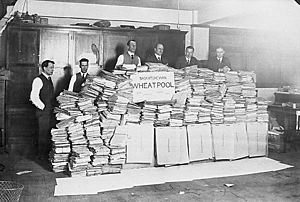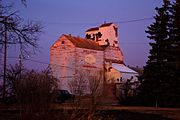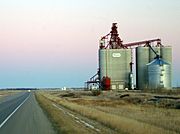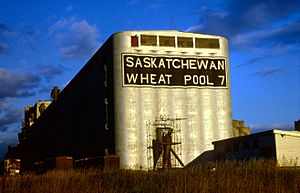Saskatchewan Wheat Pool facts for kids
 |
|
| Industry | Agriculture |
|---|---|
| Fate | Merged with Agricore United |
| Successor | Viterra |
| Founded | 1924 |
| Defunct | 2007 |
| Headquarters | 2625 Victoria Avenue, Regina, Saskatchewan |
|
Key people
|
Mayo Schmidt |
| Products | Grain buying |
|
Number of employees
|
4000 |
The Saskatchewan Wheat Pool was a big company in Regina, Saskatchewan. It helped farmers sell their grain. The company also processed food and marketed farm products.
It grew to be the largest grain handling business in Saskatchewan. The Pool worked with many partners in North America and around the world. Before it became Viterra, it had 276 stores and over 100 grain handling places.
In Manitoba and Alberta, the company was known as AgPro. It started in the 1920s as a co-operative. This means it was owned by the farmers who used its services. Later, in the 1990s, it became a public company.
In 2007, the Saskatchewan Wheat Pool took over a rival company called Agricore United. After this, the name "Saskatchewan Wheat Pool" was no longer used. The new company was called Viterra. In 2013, Glencore International bought Viterra.
Contents
How the Wheat Pool Started and Grew
Farmers in the early 1900s faced a problem. They often did not get a fair price for their wheat. So, they looked for new ways to sell their crops. One idea was to work together in a co-operative.
Around 1902, farmers formed groups like the Territorial Grain Growers' Association. This group later split into different associations. These included the Saskatchewan Grain Growers' Association (SGGA). Farmers also created co-operative elevator companies.
On August 25, 1923, the SGGA joined with other farmer groups. They formed the Saskatchewan Co-operative Wheat Producers Ltd.. People soon called it the Saskatchewan Wheat Pool. It helped farmers get a good price for their wheat.
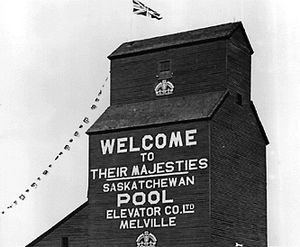
The first president was Alexander James McPhail. In 1925, the first grain elevator was built in Bulyea. A grain elevator is a tall building used to store grain. In 1926, the Saskatchewan Co-operative Wheat Producers Ltd. bought another co-operative. In 1953, the company officially changed its name to the Saskatchewan Wheat Pool.
W.A. Irwin wrote in 1929:
The pool is the world's largest farm, the world's largest shipper of wheat, the Biggest Business in Canada – and it was built by the Man Behind the Plow.
Grain elevators were important buildings in many prairie towns. They were often shown in paintings and photos. The Wheat Pool also made calendar maps. These maps showed railway lines and elevator locations. They also showed how grain handling changed over time.
Changes in Grain Handling
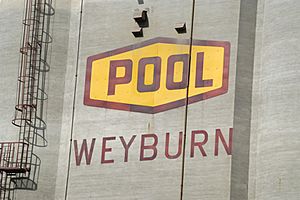
In the early 1900s, grain elevators were everywhere. They were about 6 to 10 miles apart. This was a good distance for farmers to travel with their horse and wagon. Farmers could sell their grain and have it graded at these elevators.
The Pool also had Farm Service Centers. Farmers could buy fertilizer and chemicals there. After World War II, new machines changed farming. Trucks, tractors, and combines made farming much faster.
These changes led to fewer railway lines. Grain elevators also became bigger and more modern. The old wooden elevators could handle about 100 tonnes of grain per hour. A farmer's truck might hold about 10 tonnes.
Newer elevators are made of concrete. They are called "high-throughput" elevators. These can hold huge amounts of grain, like 11,500 tonnes. Some storage facilities can hold even more. These new systems serve much larger farming areas.
From Co-operative to Public Company
In March 1996, the Saskatchewan Wheat Pool changed. It stopped being a co-operative owned by farmers. Instead, it became a public company. This meant anyone could buy shares in it.
The company made good money for a couple of years. But from 1999 to 2003, it lost a lot of money. This was because grain prices were low. It also faced more competition. Other companies like Alberta Wheat Pool and Manitoba Pool Elevators merged to form Agricore.
The Pool lost its top spot in grain handling. Agricore became even bigger when it joined with United Grain Growers in 2002. This new company was called Agricore United.
The Merger with Agricore United
In November 2006, the Saskatchewan Wheat Pool tried to buy Agricore United. Another company, James Richardson International (JRI), also wanted to buy Agricore United. The Pool first offered to trade its shares for Agricore United shares. Agricore United's leaders said no to this offer.
In February 2007, Agricore United and JRI announced they would merge. The new company would be called "Richardson Agricore." But then, a bidding war started. Both the Pool and JRI offered more money.
In May, the Pool offered $20.50 cash for each share. This was the winning offer. Most of Agricore United's shareholders agreed to sell their shares to the Pool. By June, Agricore United became fully owned by the Saskatchewan Wheat Pool.
The leaders of Agricore United left the company. The Pool's leaders took over. On June 20, 2007, Agricore United's shares were removed from the stock market. The next day, the new company's leadership was announced. The combined company was based in Regina and named Viterra.
Presidents of the Saskatchewan Wheat Pool
- A. E. Wilson (Provisional) 1923-1924
- Alexander James McPhail 1924-1931
- Louis C. Brouillette 1931-1937
- John Henry (Jack) Wesson 1937-1960
- Charles W. Gibbings 1960-1969
- E. K. Turner 1969-1987
- Garfield Stevenson 1987-1993
- Leroy Larsen 1993-1999
- Marvin Weins 1999-2004
- Terry Baker 2004-?
- Mayo Schmidt 2005-2007


